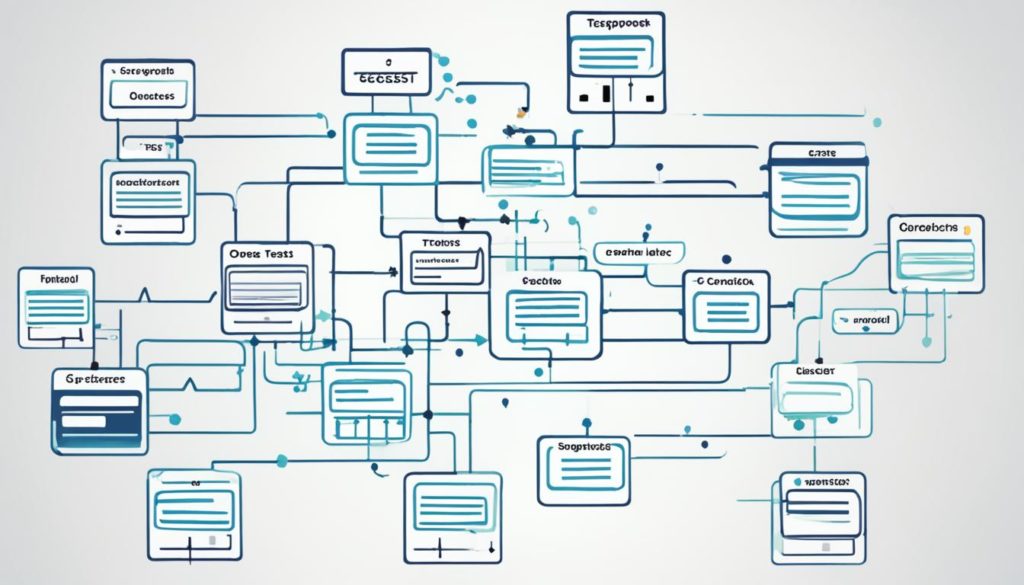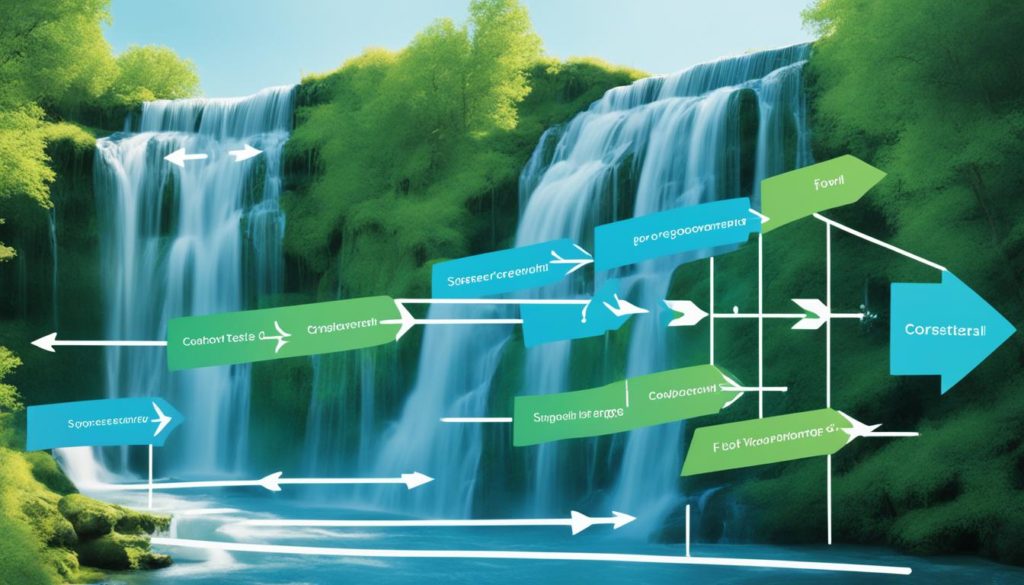
Did you know there are more than 50 software development life cycle (SDLC) models today? This shows how complex building software can be. Each model has its own benefits based on the project’s needs, size, and objectives. So, picking the right one is key for any software project start.
Choosing the correct development model is vital for your project’s success. The model directly affects your project’s quality, budget, timeline, and how happy your stakeholders are. You can opt for a predictable Waterfall or V-Model. Or, you might choose the flexibility of Agile methodologies such as Scrum and Kanban. Each method serves a purpose in the software development world.
This article will guide you through the complex world of SDLC models. We’ll look at what each model offers and the best situations to use them. This understanding will be helpful whether your project is small and simple or big and complex.
Key Takeaways
- More than 50 SDLC models are in use today, each catering to different project needs.
- Waterfall and Agile methods are among the most widely used software development models.
- The Waterfall model is best for projects with clear, unchangeable requirements and predictable schedules.
- Agile methodologies, like Scrum and Kanban, offer flexibility and early feedback, crucial for innovative and complex projects.
- Selecting the right SDLC model impacts the project’s quality, budget, and timeline significantly.
- Our article distills the essence of the 8 most popular SDLC models, guiding you to an optimal path for your software development needs.
- Understand the SDLC models to enhance project management and stakeholder satisfaction.
Understanding Software Development Models
Software development models are key in software project management. They offer a clear way to make top-notch software. These models break the work into steps. These steps take us from starting the project to making and launching the software.
What are Software Development Models?
Think of software development models as maps. These maps show us the route through the SDLC phases. Each map, or model, guides teams differently. It helps them stay on track and make sure the work is done well. By knowing these models, teams can pick the one that fits their project and their skills best.
Types of Software Development Models
There are many software development models. Each one is good for certain kinds of projects:
- Waterfall model: A linear and sequential approach where each phase must be completed before the next one begins.
- V-model: Emphasizes verification and validation, mapping phases of development to corresponding testing phases.
- Agile methodology: Focuses on iterative and incremental development, promoting adaptive planning and early delivery.
- Incremental model: Develops the system through repeated cycles (increments), gradually adding to the functionality.
- Iterative model: Cycles through a series of versions, each improving upon the last until the final product is achieved.
Choosing the best model involves looking at many things. You consider how hard the project is, what the client wants, and how the team is set up. Knowing about these models helps match the project with the right model. This makes software project management work better.
Waterfall and V-Model: Linear Approaches
In software development, two famous models follow linear paths: the Waterfall Model and the V-Model. Both are about moving step-by-step through the project, focusing greatly on checking and double-checking as we go. They stress making sure each stage is complete before starting the next.
Waterfall Model
The Waterfall Model shows a linear SDLC method. It moves in a straight line through tasks like analysis, design, coding, testing, and deployment. Each phase depends on the previous one finishing first. It aims to be predictable and well-documented at every step. It’s clear and easy to follow, yet inflexible for changing needs. Customers get involved early but might not see results until the end. Testing happens after developing, which could find problems late. Even with its flaws, it’s a very well-known way to develop software.
V-Model (Validation and Verification Model)
The V-Model, created in the 1980s by Paul Rook, builds on the linear approach. It links each development step with testing, starting from the project’s beginning. This testing-first method catches issues early, boosting quality. But, it can be more expensive and complex. The V-Model is more adaptable than the Waterfall, with its steps allowing for some changes. It promises stronger quality and is widely used where projects need to meet strict quality standards.
Comparing Waterfall and V-Model shows their flexibility, cost, and quality management benefits:
| Aspect | Waterfall Model | V-Model |
|---|---|---|
| Cost | Low | High |
| Complexity | Simple | Intermediate |
| Flexibility | Rigid | Little Flexible |
| Reusability | Limited | Can be reused to some extent |
| User Involvement | Only at the beginning | Only at the beginning |
| Testing Activities Start | After development | With the first stage |
| Guarantee of Success | Low | High |
| Defects | Fewer | More |
| Usage | Less used nowadays | Widely used |
Each model, Waterfall and V-Model, has its benefits and challenges that must be considered based on the project.
Iterative and Incremental Models
Iterative and incremental development models are great for big, complex projects. They use a step-by-step approach to build software. Each step allows for changes based on feedback received during the last step. This way, the software gets better with each cycle.
Incremental builds start with a strong foundation. This makes sure the main parts are set early. Then, more features are added in each cycle as the project moves forward. It helps keep the project steady, even when small changes are needed.
Incremental Model
Incremental builds break the project into phases. Each phase completes a usable part of the software. Risks are lower because of the step-by-step approach. This also allows for continuous feedback and makes the project flexible.
Companies like the incremental model for its stability and the ability to add small updates easily. This method helps keep the project on track while responding to new needs.
Iterative Model
The iterative model involves repeating work cycles. Each cycle makes the software better by adding feedback and making changes. This process excels in projects that evolve over time and need to adapt quickly.
It’s perfect for complex projects that require frequent improvements. The iterative model allows for change without losing sight of the project’s main goals.
Using both models together creates a powerful solution for big projects. This strategy helps build strong, adaptable software. It’s perfect for making systems that can grow and change with time.
Agile Methodology: Modern Software Development Models
Agile practices have changed how we make software, focusing on working in small steps, talking a lot with customers, and being ready to change plans quickly. This way of working has become very important in updating old software and starting new digital projects. We will look at two top methods in Agile, the Scrum Framework and the Kanban Method.
Scrum Framework
The Scrum Framework is all about small, focused work periods called Scrum sprints. A team usually works on something for one to four weeks and then shows what they’ve done. This method includes key meetings like planning, daily check-ins, and reflection, where everyone talks about what they can do better. It lets teams make a lot of decisions and always improve, aiming to meet both user needs and business targets.
The work with Agile development starts with understanding who will use the software and setting a clear goal. It includes people from different areas like coding, design, and leadership. Scrum is great for always getting better at what you do and working closely with customers. Its goal is to keep everyone moving in the right direction.
Kanban Method
Unlike Scrum’s set timeframes, Kanban focuses on always moving tasks from ‘to do’ to ‘done’. Teams use a board to see what work is going on and where it is. This board helps show what’s happening clearly, making it easier for the team to react fast to changes and meet what the customer wants.
With Kanban, it’s important to check how things are going and do better often. Tools like Jira and Azure DevOps can help keep everything in line. Kanban works well with other ideas like design thinking and DevOps. This shows how well it can fit into different situations.
Both Scrum and Kanban are key in Agile, focusing on small steps and talking a lot to customers. They aim to always deliver high-quality software that meets what users and companies need. By always improving and listening to feedback, Agile methods keep the software world moving forward.
| Aspect | Scrum Framework | Kanban Method |
|---|---|---|
| Work Organization | Time-boxed Scrum sprints | Continuous flow of tasks |
| Tools | Jira, Azure DevOps | Kanban board, Jira |
| Meetings | Sprint planning, Daily standup, Sprint review, Retrospectives | Regular process reviews |
| Flexibility | Adaptive within sprints | Flexibly adjusts to changes |
| Focus | Incremental improvements | Process visualization |
Want to know more about Agile? Check Agile methodology overview for its main ideas and benefits.
Conclusion
Choosing the right SDLC model is key to software project success. Each model has its own strengths. The Waterfall and V-Model are great for projects with clear steps. They provide a path to follow without many changes. Yet, for projects that might change their needs, the Incremental and Iterative models can be more helpful.
Today, methods like Scrum and Kanban are very popular. They focus on being flexible and working closely together. These methods help teams respond to changes fast. They aim to make software that fits the market’s needs as they change. It’s crucial to pick the best SDLC model for each project. This choice should match the goals of the project and the skills of the team.
The world of software development is always changing. We need to stay up-to-date and learn new things. Choosing the best SDLC model means our projects can adapt and get better over time. This way, we make software that everyone likes and finds useful. The right strategy is vital for the success of any software project.
FAQ
What are Software Development Models?
Software Development Models are like blueprints for creating software. They list steps to follow. By following these steps, developers stay organized and ensure their software meets high standards.
What are the main types of Software Development Models?
The key Software Development Models include the likes of the Waterfall Model and Agile models like Scrum and Kanban. Each model offers a different way to approach building software. They help teams select the best path for their project.
What is the Waterfall Model?
The Waterfall Model is a methodical way of making software. Here, each step is finished before the next starts. It’s known for its clear phases and heavy emphasis on detailed documentation.
What is the V-Model?
The V-Model takes quality assurance a step further from the Waterfall. It matches a testing step with the development step it verifies. This strategy is great for projects with strictly set and lasting requirements.
How do the Incremental and Iterative Models differ?
The Incremental Model adds features in smaller bits, as if building in layers. The Iterative Model involves repeating cycles to enhance the software. These methods are fitting for large projects needing adjustments over time.
What is the Scrum Framework?
Scrum is an Agile approach using ‘sprints’ to achieve goals in short cycles. It enhances team dynamic and allows for quick responses to feedback. This method encourages constant improvement through teamwork.
How does the Kanban Method work?
Kanban is about steady output and keeping the process visible. It relies on a visual board to show tasks and their progress. This way, teams can easily spot areas where they can improve and keep their flow steady.
Future App Studios is an award-winning software development & outsourcing company. Our team of experts is ready to craft the solution your company needs.










